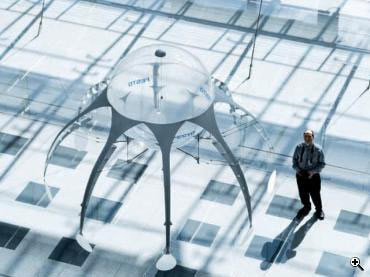Glider shaped jellyfish
Have you ever wondered if anything could glide in the sky like jellyfish swimming in the water? The German scientists at Festo have built such a device.
The "AirJelly" , flying in the air with extraordinary accuracy and flexibility, simulates the movement of jellyfish in the country and adheres to the principles of this marine animal.
Surprisingly, it is surprising that so far, the similarity between air and water environments has not inspired the mimicking of marine organism's propulsion mechanisms in the aviation sector.
The 'AirJelly' is a robot that is not remotely controlled via radio, has a smart adaptive mechanism and a central electronic rudder. Weighing only 1.3 kg and measuring 2.2 x 1.35 meters, this device includes an extremely light helium-filled balloon.

AirJelly is a flying robot that simulates jellyfish activities.(Photo: TFOT)
The 8 fringes also move like a real jellyfish. Thanks to the movement of a pendulum in the center of the system, AirJelly can "swim" in a certain direction.
"With this product, Festo is proving that a central electronic rudder system combined with an intelligent mechanism will open exciting opportunities for the construction of propulsion systems for ultralight flights". company statement.
Airline is not the first project that Festo incorporates biomimetic principles, some of the company's impressive projects include "Airacuda" - remote controls, and AirRay - a hot air balloon. The remote control is filled with helium and built with a flap mechanism.
- Giant jellyfish drifted off the coast of Australia
- 65 interesting things about jellyfish (1)
- Successfully cultured new shaped jellyfish
- Jellyfish species can 'knock down' American carriers
- 65 interesting things about jellyfish (2)
- Beautiful sparkling jellyfish kingdom
- Do you know how jellyfish burn us?
- Beauty of jellyfish in the dark
- Startled with the danger of jellyfish invading the oceans
- Jellyfish cannot 'invade' the planet
- The first purple jellyfish on the planet
- Jellyfish used to have skeleton frames during evolution
 Daily use inventions come from universities
Daily use inventions come from universities Special weight loss device helps prevent appetite
Special weight loss device helps prevent appetite 8 inventors were killed by their own inventions
8 inventors were killed by their own inventions Iran invented a motor car powered by water
Iran invented a motor car powered by water